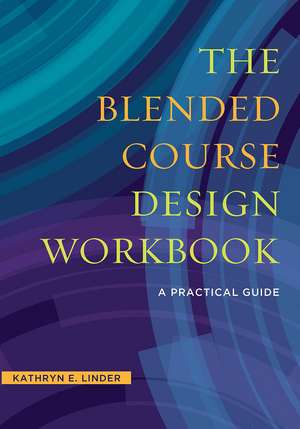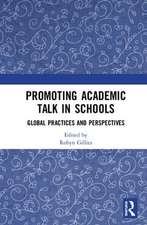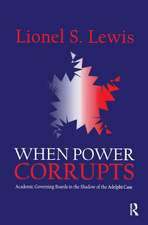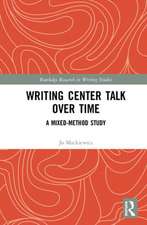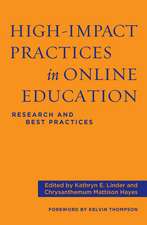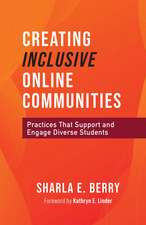The Blended Course Design Workbook: A Practical Guide
Autor Kathryn E. Linderen Limba Engleză Paperback – 8 noi 2016
| Toate formatele și edițiile | Preț | Express |
|---|---|---|
| Paperback (1) | 348.61 lei 6-8 săpt. | |
| Taylor & Francis – 8 noi 2016 | 348.61 lei 6-8 săpt. | |
| Hardback (1) | 949.60 lei 6-8 săpt. | |
| Taylor & Francis – 11 noi 2016 | 949.60 lei 6-8 săpt. |
Preț: 348.61 lei
Nou
Puncte Express: 523
Preț estimativ în valută:
66.72€ • 69.39$ • 55.08£
66.72€ • 69.39$ • 55.08£
Carte tipărită la comandă
Livrare economică 14-28 aprilie
Preluare comenzi: 021 569.72.76
Specificații
ISBN-13: 9781620364369
ISBN-10: 1620364360
Pagini: 224
Dimensiuni: 152 x 229 x 20 mm
Greutate: 0.44 kg
Ediția:1
Editura: Taylor & Francis
Colecția Routledge
Locul publicării:Oxford, United Kingdom
ISBN-10: 1620364360
Pagini: 224
Dimensiuni: 152 x 229 x 20 mm
Greutate: 0.44 kg
Ediția:1
Editura: Taylor & Francis
Colecția Routledge
Locul publicării:Oxford, United Kingdom
Public țintă
Postgraduate and Professional Practice & DevelopmentNotă biografică
Dr. Katie Linder is currently the executive director for program development at Kansas State University Global Campus. Previously, she directed the award-winning Ecampus Research Unit at Oregon State University. Katie is also a Certified Coach through the International Coach Federation. Katie is an avid writer and researcher with a passion for process and peeking behind the scenes at what it takes to be a successful academic. For the past several years, her work has focused on blended course design best practices, institutional supports for accessible online learning, and research literacy for scholarship of teaching and learning practitioners and distance education stakeholders. She speaks on topics related to writing and publication; creativity and productivity; self-promotion and personal branding; and teaching and learning with technology.Her latest works include Going Alt-Ac: A Guide to Alternative Academic Careers (Stylus, 2020; co-authored with Kevin Kelly and Tom Tobin), Managing Your Professional Identity Online: A Guide for Faculty, Staff, and Administrators (Stylus, 2018), High-Impact Practices in Online Education (Stylus, 2018), and The Business of Innovating Online (Stylus, 2019). She is also the author of The Blended Course Design Workbook: A Practical Guide (Stylus, 2016). Katie earned her BA in English Literature from Whitworth University in Spokane, WA, and her MA and PhD in Women’s, Gender, and Sexuality Studies from The Ohio State University.Visit her personal website at: https://drkatielinder.com
Cuprins
Tables, Figures, and Boxes Acknowledgments Introduction. Why Blended, Why Now? 1. Fundamentals of Blended Teaching and Learning 2. Writing Course Goals and Learning Objectives-- With Danny Fontaine 3. Assessing Student Learning in Your Blended Course 4. Online Assessment Tools-- With Linda Bruenjes 5. Designing Effective Learning Activities 6. Mapping Your Blended Course 7. Getting to Know Your Learning Management System-- With Sarah Smith 8. Creating Social Presence in Your Blended Course-- With Victoria Wallace 9. Finding Resources Online 10. Creating Multimedia Resources 11. Mobile Devices, Apps, and Social Media--With Victoria Wallace 12. The Blended Course Syllabus 13. Preparing Your Students for Success Conclusion. Getting Ready to Launch Glossary Appendices References About the Contributors Index
Recenzii
“The Blended Course Design Workbook brings together the best practices in online learning and residential teaching in a single concise volume and provides a wealth of resources, checklists, and step-by-step instructions essential for the development and teaching of cutting-edge college courses.”
Joshua Kim, Director of Digital Learning Initiatives
Dartmouth Center for the Advancement of Learning (DCAL)
“The Blended Course Design Workbook: A Practical Guide is a very useful guide for instructors transitioning from traditional to blended delivery. Linder explains how to write course goals and objectives, how to assess students online, and how to design effective learning activities. She also explains how to use technology to support learning, how to access suitable online resources, how to organize blended courses, and how to support online learners.
I find the step-by-step guides, templates, and checklists to be very useful, particularly as they build on one another. In addition, Linder’s references to theories and principles at the start of each chapter give instructors a sound footing on which to design their blended courses. The book’s tone is encouraging, which makes for an easy read.”
Technical Communication
"For the faculty member transitioning a course from face-to-face (F2F) to an online or blended learning environment, Kathryn Linder’s workbook is a wonderful resource. After opening with chapters reviewing the key components of backward course design, developing appropriate course learning objectives, and assessment, the remaining chapters provide a step-by-step guide for an instructor to convert a course from a physical to a virtual teaching space.
The book’s main strength is its highly practical nature, highlighted by the ready-to-use worksheets, templates, and checklists for every step in the process. Not only does it explain the desired resources, it usually gives real-life examples of how the tool was used in a blended classroom effectively.
Given the practical nature of this workbook and its many ready-to-copy worksheets, it is strongly recommended for faculty members transitioning a classroom course to a blended or online delivery format. Likewise, academic deans leading a group of faculty through a similar transition process will find this a one-stop resource, especially if they are able to partner with an educational technologist.”
Reflective Teaching (Wabash Center)
“Katie Linder has written practical, smart, and even compassionate book on blended course design. Drawing on both research and experience, she walks readers through the process of creating blended courses that will challenge and engage students, providing plenty of examples and tips along the way. This is the essential guide we need to ensure our students will be successful in blended courses.”
Peter Felten, Assistant Provost for Teaching & Learning
Elon University
“The perfect mix of theory and practice, The Blended Course Design Workbook equips you to teach your first blended course, re-design an existing class to be more effective, or even launch an entire blended program at your institution.”
Bonni Stachowiak, Associate Professor of Business and Management
Vanguard University and host of the Teaching in Higher Ed podcast
“Katie Linder’s Blended Course Design Workbook is a solid, practical resource for faculty embracing blended learning. Linder is mindful of the needs of faculty for whom technology-mediated teaching/learning is not a field of study but a craft. Faculty and faculty developers alike will find many practical tools for use in their professional practice.”
Kelvin Thompson, Director of Online Design & Development Strategy
University of Central Florida
Joshua Kim, Director of Digital Learning Initiatives
Dartmouth Center for the Advancement of Learning (DCAL)
“The Blended Course Design Workbook: A Practical Guide is a very useful guide for instructors transitioning from traditional to blended delivery. Linder explains how to write course goals and objectives, how to assess students online, and how to design effective learning activities. She also explains how to use technology to support learning, how to access suitable online resources, how to organize blended courses, and how to support online learners.
I find the step-by-step guides, templates, and checklists to be very useful, particularly as they build on one another. In addition, Linder’s references to theories and principles at the start of each chapter give instructors a sound footing on which to design their blended courses. The book’s tone is encouraging, which makes for an easy read.”
Technical Communication
"For the faculty member transitioning a course from face-to-face (F2F) to an online or blended learning environment, Kathryn Linder’s workbook is a wonderful resource. After opening with chapters reviewing the key components of backward course design, developing appropriate course learning objectives, and assessment, the remaining chapters provide a step-by-step guide for an instructor to convert a course from a physical to a virtual teaching space.
The book’s main strength is its highly practical nature, highlighted by the ready-to-use worksheets, templates, and checklists for every step in the process. Not only does it explain the desired resources, it usually gives real-life examples of how the tool was used in a blended classroom effectively.
Given the practical nature of this workbook and its many ready-to-copy worksheets, it is strongly recommended for faculty members transitioning a classroom course to a blended or online delivery format. Likewise, academic deans leading a group of faculty through a similar transition process will find this a one-stop resource, especially if they are able to partner with an educational technologist.”
Reflective Teaching (Wabash Center)
“Katie Linder has written practical, smart, and even compassionate book on blended course design. Drawing on both research and experience, she walks readers through the process of creating blended courses that will challenge and engage students, providing plenty of examples and tips along the way. This is the essential guide we need to ensure our students will be successful in blended courses.”
Peter Felten, Assistant Provost for Teaching & Learning
Elon University
“The perfect mix of theory and practice, The Blended Course Design Workbook equips you to teach your first blended course, re-design an existing class to be more effective, or even launch an entire blended program at your institution.”
Bonni Stachowiak, Associate Professor of Business and Management
Vanguard University and host of the Teaching in Higher Ed podcast
“Katie Linder’s Blended Course Design Workbook is a solid, practical resource for faculty embracing blended learning. Linder is mindful of the needs of faculty for whom technology-mediated teaching/learning is not a field of study but a craft. Faculty and faculty developers alike will find many practical tools for use in their professional practice.”
Kelvin Thompson, Director of Online Design & Development Strategy
University of Central Florida
Descriere
Blended (also called hybrid) classrooms, in which face-to-face interaction is intentionally combined with online activities to aid student learning, are becoming more and more common.
